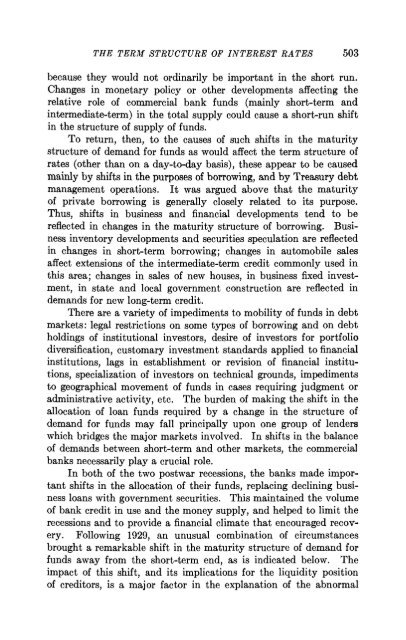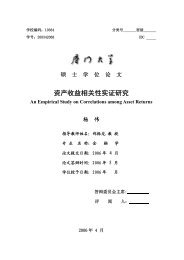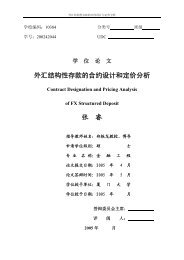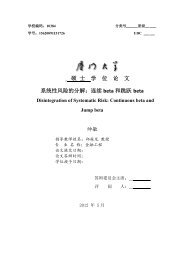The Term Structure of Interest Rates
The Term Structure of Interest Rates
The Term Structure of Interest Rates
Create successful ePaper yourself
Turn your PDF publications into a flip-book with our unique Google optimized e-Paper software.
THE TERM STRUCTURE OF INTEREST RATES 503<br />
because they would not ordinarily be important in the short run.<br />
Changes in monetary policy or other developments affecting the<br />
relative role <strong>of</strong> commercial bank funds (mainly short-term and<br />
intermediate-term) in the total supply could cause a short-run shift<br />
in the structure <strong>of</strong> supply <strong>of</strong> funds.<br />
To return, then, to the causes <strong>of</strong> such shifts in the maturity<br />
structure <strong>of</strong> demand for funds as would affect the term structure <strong>of</strong><br />
rates (other than on a day-to-day basis), these appear to be caused<br />
mainly by shifts in the purposes <strong>of</strong> borrowing, and by Treasury debt<br />
management operations. It was argued above that the maturity<br />
<strong>of</strong> private borrowing is generally closely related to its purpose.<br />
Thus, shifts in business and financial developments tend to be<br />
reflected in changes in the maturity structure <strong>of</strong> borrowing. Business<br />
inventory developments and securities speculation are reflected<br />
in changes in short-term borrowing; changes in automobile sales<br />
affect extensions <strong>of</strong> the intermediate-term credit commonly used in<br />
this area; changes in sales <strong>of</strong> new houses, in business fixed investment,<br />
in state and local government construction are reflected in<br />
demands for new long-term credit.<br />
<strong>The</strong>re are a variety <strong>of</strong> impediments to mobility <strong>of</strong> funds in debt<br />
markets: legal restrictions on some types <strong>of</strong> borrowing and on debt<br />
holdings <strong>of</strong> institutional investors, desire <strong>of</strong> investors for portfolio<br />
diversification, customary investment standards applied to financial<br />
institutions, lags in establishment or revision <strong>of</strong> financial institutions,<br />
specialization <strong>of</strong> investors on technical grounds, impediments<br />
to geographical movement <strong>of</strong> funds in cases requiring judgment or<br />
administrative activity, etc. <strong>The</strong> burden <strong>of</strong> making the shift in the<br />
allocation <strong>of</strong> loan funds required by a change in the structure <strong>of</strong><br />
demand for funds may fall principally upon one group <strong>of</strong> lenders<br />
which bridges the major markets involved. In shifts in the balance<br />
<strong>of</strong> demands between short-term and other markets, the commercial<br />
banks necessarily play a crucial role.<br />
In both <strong>of</strong> the two postwar recessions, the banks made important<br />
shifts in the allocation <strong>of</strong> their funds, replacing declining business<br />
loans with government securities. This maintained the volume<br />
<strong>of</strong> bank credit in use and the money supply, and helped to limit the<br />
recessions and to provide a financial climate that encouraged recovery.<br />
Following 1929, an unusual combination <strong>of</strong> circumstances<br />
brought a remarkable shift in the maturity structure <strong>of</strong> demand for<br />
funds away from the short-term end, as is indicated below. <strong>The</strong><br />
impact <strong>of</strong> this shift, and its implications for the liquidity position<br />
<strong>of</strong> creditors, is a major factor in the explanation <strong>of</strong> the abnormal

















